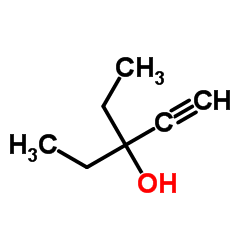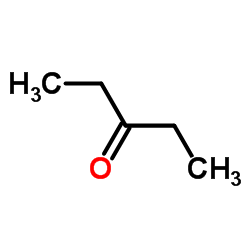3234-64-8
| Name | 3-ethylpent-1-yn-3-amine |
|---|---|
| Synonyms |
3-amino-3-ethyl-1-pentyne
diethylpropargyl amine 1-(1,1-diethyl-2-propynyl)-amine 1,1-diethyl-prop-2-ynylamine EINECS 221-784-2 1-Pentyn-3-amine,3-ethyl 3-Amino-3-ethyl-pentyne 1,1-Diethylpropargylamine 1,1-diethyl-2-propyn-1-ylamine |
| Density | 0.845 g/cm3 |
|---|---|
| Boiling Point | 132.7ºC at 760 mmHg |
| Molecular Formula | C7H13N |
| Molecular Weight | 111.18500 |
| Flash Point | 21.1ºC |
| Exact Mass | 111.10500 |
| PSA | 26.02000 |
| LogP | 1.83740 |
| Index of Refraction | n20/D 1.4409(lit.) |
Synonym:None Section 2 - COMPOSITION, INFORMATION ON INGREDIENTS
Risk Phrases: 11 34 Section 3 - HAZARDS IDENTIFICATION EMERGENCY OVERVIEW
Highly flammable. Causes burns. Potential Health Effects Eye: May cause eye irritation. Skin: Prolonged and/or repeated contact may cause irritation and/or dermatitis. Product tests non-reactive for HBsAg and negative for antibodies to HIV and HCV. However, material should be handled as potentially infectious. Ingestion: May cause irritation of the digestive tract. Inhalation: Prolonged exposure may result in dizziness and general weakness. Chronic: No information found. Section 4 - FIRST AID MEASURES Eyes: Flush eyes with plenty of water for at least 15 minutes, occasionally lifting the upper and lower eyelids. Get medical aid immediately. Skin: Get medical aid. Flush skin with plenty of water for at least 15 minutes while removing contaminated clothing and shoes. Remove contaminated clothing and shoes. Flush skin with plenty of soap and water. Ingestion: If victim is conscious and alert, give 2-4 cupfuls of milk or water. Get medical aid. Get medical aid immediately. Inhalation: Get medical aid immediately. Remove from exposure and move to fresh air immediately. If not breathing, give artificial respiration. If breathing is difficult, give oxygen. Notes to Physician: Section 5 - FIRE FIGHTING MEASURES General Information: As in any fire, wear a self-contained breathing apparatus in pressure-demand, MSHA/NIOSH (approved or equivalent), and full protective gear. Flammable liquid and vapor. Extinguishing Media: For small fires, use water spray, dry chemical, carbon dioxide or chemical foam. Use agent most appropriate to extinguish fire. Section 6 - ACCIDENTAL RELEASE MEASURES General Information: Use proper personal protective equipment as indicated in Section 8. Spills/Leaks: Absorb spill with inert material (e.g. vermiculite, sand or earth), then place in suitable container. Clean up spills immediately, observing precautions in the Protective Equipment section. In case of spill, sweep up solid or absorb liquid with inert material, then place into a biohazard container. Wear protective equipment. Section 7 - HANDLING and STORAGE Handling: Wash thoroughly after handling. Use with adequate ventilation. Avoid contact with skin and eyes. Empty containers retain product residue, (liquid and/or vapor), and can be dangerous. Keep away from heat, sparks and flame. Avoid ingestion and inhalation. Do not pressurize, cut, weld, braze, solder, drill, grind, or expose empty containers to heat, sparks or open flames. Storage: Keep away from heat, sparks, and flame. Store in a cool place in the original container and protect from sunlight. Refrigerator/flammables. Section 8 - EXPOSURE CONTROLS, PERSONAL PROTECTION Engineering Controls: Good general ventilation should be sufficient to control airborne levels. Use process enclosure, local exhaust ventilation, or other engineering controls to control airborne levels. Exposure Limits CAS# 3234-64-8: Personal Protective Equipment Eyes: Wear chemical splash goggles. Wear appropriate protective eyeglasses or chemical safety goggles as described by OSHA's eye and face protection regulations in 29 CFR 1910.133 or European Standard EN166. Skin: Wear appropriate protective gloves to prevent skin exposure. Clothing: Wear appropriate protective clothing to minimize contact with skin. Wear appropriate protective clothing to prevent skin exposure. Respirators: A respiratory protection program that meets OSHA's 29 CFR 1910.134 and ANSI Z88.2 requirements or European Standard EN 149 must be followed whenever workplace conditions warrant respirator use. Follow the OSHA respirator regulations found in 29 CFR 1910.134 or European Standard EN 149. Use a NIOSH/MSHA or European Standard EN 149 approved respirator if exposure limits are exceeded or if irritation or other symptoms are experienced. Section 9 - PHYSICAL AND CHEMICAL PROPERTIES Physical State: Solid Color: clear, colorless Odor: Odorless. pH: Not available. Vapor Pressure: Not available. Viscosity: Not available. Boiling Point: 71.0 - 72.0 deg C @ 90.00mm H Freezing/Melting Point: 0 deg C Autoignition Temperature: Not available. Flash Point: 21 deg C ( 69.80 deg F) Explosion Limits, lower: Not available. Explosion Limits, upper: Not available. Decomposition Temperature: Solubility in water: Specific Gravity/Density: .8280g/cm3 Molecular Formula: C7H13N Molecular Weight: 111.19 Section 10 - STABILITY AND REACTIVITY Chemical Stability: Stable under normal temperatures and pressures. Conditions to Avoid: Incompatible materials, none reported, strong oxidants. Incompatibilities with Other Materials: None reported. Hazardous Decomposition Products: None, irritating and toxic fumes and gases. Hazardous Polymerization: Has not been reported Section 11 - TOXICOLOGICAL INFORMATION RTECS#: CAS# 3234-64-8 unlisted. LD50/LC50: Not available. Carcinogenicity: 1,1-diethylpropargylamine, 97% - Not listed by ACGIH, IARC, or NTP. Section 12 - ECOLOGICAL INFORMATION Section 13 - DISPOSAL CONSIDERATIONS Dispose of in a manner consistent with federal, state, and local regulations. Section 14 - TRANSPORT INFORMATION IATA Shipping Name: AMINES, FLAMMABLE, CORROSIVE, N.O.S.* Hazard Class: 3 (8) UN Number: 2733 Packing Group: II IMO Shipping Name: AMINES, FLAMMABLE, CORROSIVE, N.O.S. Hazard Class: 3.2 (8) UN Number: 2733 Packing Group: II RID/ADR Shipping Name: AMINES, FLAMMABLE, CORROSIVE, N.O.S. Hazard Class: 3 UN Number: 2733 Packing group: II Section 15 - REGULATORY INFORMATION European/International Regulations European Labeling in Accordance with EC Directives Hazard Symbols: F C Risk Phrases: R 11 Highly flammable. R 34 Causes burns. Safety Phrases: S 16 Keep away from sources of ignition - No smoking. S 23 Do not inhale gas/fumes/vapour/spray. WGK (Water Danger/Protection) CAS# 3234-64-8: No information available. Canada None of the chemicals in this product are listed on the DSL/NDSL list. CAS# 3234-64-8 is not listed on Canada's Ingredient Disclosure List. US FEDERAL TSCA CAS# 3234-64-8 is not listed on the TSCA inventory. It is for research and development use only. SECTION 16 - ADDITIONAL INFORMATION N/A |
| Hazard Codes | F: Flammable;C: Corrosive; |
|---|---|
| Risk Phrases | R11 |
| Safety Phrases | 16-26-36/37/39-45 |
| RIDADR | UN 2733 |
| Packaging Group | II |
| Hazard Class | 3.1 |
| HS Code | 2921199090 |
|
~75% 
3234-64-8 |
| Literature: Kopka, Ihor E.; Fataftah, Zacharia A.; Rathke, Michael W. Journal of Organic Chemistry, 1980 , vol. 45, # 23 p. 4616 - 4622 |
|
~% 
3234-64-8 |
| Literature: Journal of Organic Chemistry, , vol. 45, # 23 p. 4616 - 4622 |
|
~% 
3234-64-8 |
| Literature: Journal of Organic Chemistry, , vol. 45, # 23 p. 4616 - 4622 |
| HS Code | 2921199090 |
|---|---|
| Summary | 2921199090 other acyclic monoamines and their derivatives; salts thereof VAT:17.0% Tax rebate rate:9.0% Supervision conditions:none MFN tariff:6.5% General tariff:30.0% |


